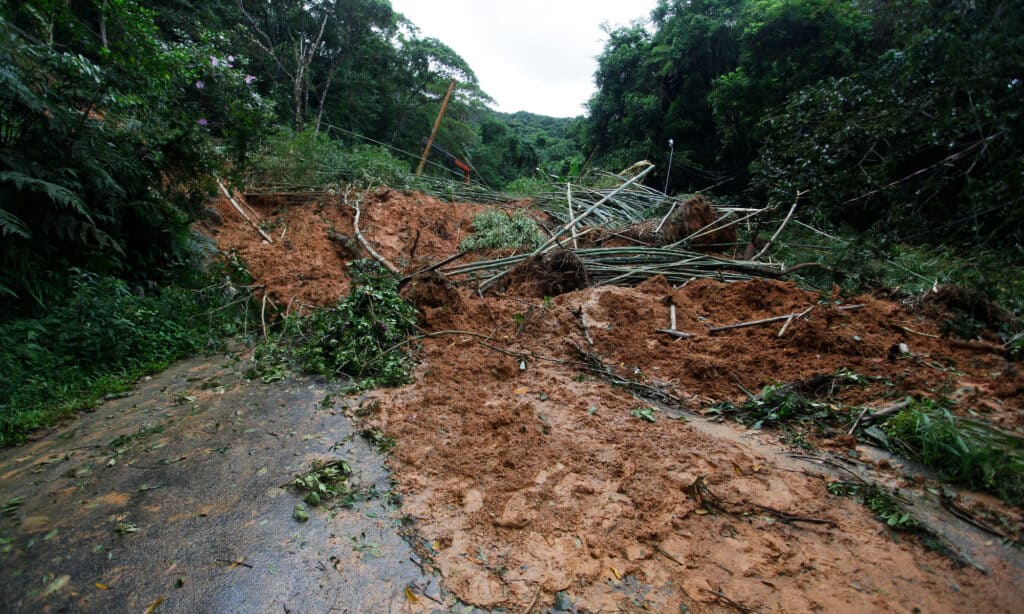Mudslides can be quite devastating, especially when they occur around populated cities. Places with steep terrain that experience extreme rainfall are prone to mudslides as excessive water puts pressure on the dirt, making it. While mudslides can occur in any state, places like California, Oregon, Washington, Alaska, and Hawaii are especially at risk. If you reside in the Golden State, here are some facts and tips for preparing for mudslides in California.
What Is a Mudslide?

Wildfires make conditions for mudslides much more likely.
©iStock.com/kiwisoul
A mudslide is when a large quantity of wet soil, clay, and/or silt moves suddenly and quickly down a steep slope. The surge can be so severe that trees, cars, and people are swept up in its flow. Usually, areas with sparse vegetation or have been damaged by wildfires are prone to mudslides after heavy rain.
Mudslide vs. Landslide
A landslide is a broad term encompassing any mass of earth or rock sliding down a mountain or cliff. The movement can be fast or slow and can be triggered by water, but not necessarily.
A mudslide is a type of landslide typified by fast and rushing amounts of saturated soil down an incline. It is caused by heavy rain or flooding, and its liquid-like composition often flows down in channels.
Why Is California Prone to Mudslides?

Any mountainside or hillside is at risk for mudslides even three to five years after a wildfire has occurred.
©Nelson Antoine/Shutterstock.com
The steep terrain and mountains in California have loose sediment and soil deposits, which can easily slough off in wet conditions. Also, the state’s droughts have made the ground hard, affecting the absorbency of the soil. As heavy rain runs over the hardened ground, the water picks up speed, accumulating the soil and debris.
The wildfires are also devastating. It leaves hillsides bare with no vegetation to trap the soil. With no barriers, the mudslide continues downward without slowing.
Most Vulnerable Areas in California to Mudslides
Areas by steep inclines previously affected by wildfires within the past three years are most at risk. This includes Napa, Mariposa, and Monterey counties. The lethal mudslide in 2018, which overwhelmed Montecito, happened right after one of the largest wildfires destroyed 280,000 acres in the area.
In general, Southern California and the San Francisco Bay Area are the most at risk for mudslides.
How Many Mudslides Have Been Recorded in California?

Mudslides can break electrical, water, gas, or sewage lines. You should report any utility damage so that they may be turned off as quickly as possible.
©iStock.com/Svetlana123
In January of 2023 alone, the California Geological Survey and the U.S. Geological Survey recorded 700 landslides and mudslides in California. By April 2023, the state experienced 150 percent of its average precipitation, with some areas seeing 200 percent of what is typical. That much rain is a recipe for mudslide events.
What Is the Worst Mudslide to Ever Happen in California?
One of the worst mudslides in California was in February 2017 in Big Sur. One of the factors, scientists say, was the severe drought that Big Sur experienced for several years. Then, in February of 2017, heavy storms swept through the area. The combination of landslide and mudslide comprised six million cubic yards of debris obstructing the Pacific Coast Highway. Considered the largest in state history, it took $54 million to repair damages done by the Big Sur Landslide. The repairs took over a year to complete. Other huge landslides in California’s history show how devastating they can be.
Steps to Take to Prepare for Mudslides in California

According to the CDC, in the United States, landslides and mudslides account for 25 to 50 deaths annually.
©U.S. Coast Guard District 11 PADET Los Angeles District 11 PADET Los Angeles / public domain – Original
Before a mudslide even occurs, there are many precautions you can take to prepare. Here are some good steps to take ahead of time:
- Have an emergency kit in your home. This includes food and fresh water, which can last several days, a first aid kit, a flashlight, a local map, a manual can opener for food, extra batteries, plastic sheeting or a tent for shelter, hand sanitizer, and wipes for personal sanitation.
- Have a family plan where everyone knows what to do and where to meet in the event of a mudslide.
- Sign up for local emergency alerts.
- Consult your insurance agent to see if you are in a landslide risk area and what your coverage is under your flood insurance policy.
During a Mudslide Warning:
- Stay updated about recent alerts or evacuation instructions from local emergency managers.
- Do not cross any road or bridge where you see mud or water flowing. The mudslide could pick up speed before you are safely across.
- Avoid river valleys and travel uphill away from the mudslide path as soon as possible.
- Watch for flash floods, as the same weather conditions cause floods and mudslides.
- Report any damage to roads, utility lines, or other hazards to authorities to make sure those areas are rerouted and utilities turned off.
After a mudslide, have a professional evaluate the damage to your house or foundation. Also, consult a geotechnical expert for corrective measures for your home in the future.
The photo featured at the top of this post is © Nelson Antoine/Shutterstock.com
Thank you for reading! Have some feedback for us? Contact the AZ Animals editorial team.







